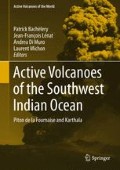Abstract
In 2011 a research project on volcanic risk assessment at La Réunion Island (Project Aléa, Institute de Physique du Globe de Paris, France) was conducted in order to determine more efficient strategies to manage future volcanic crises. The project included the evaluation of volcanic scenarios through field and historical data analysis, as well as a survey on volcanic risk perception in resident population. A clear scientific information and an effective communication with public play a crucial role in risk mitigation strategies. Moreover the evaluation of the public perception during both volcanic crises and dormant periods is an important element in developing actions focused on specific social and cultural contexts. For this porpose a questionnaire was developed based on the ones used in similar researches conducted on Italian active volcanoes. Items were designed to measure variables connected with personal perception of hazard and risk, trust in mitigation actions and in information received about these aspects. In addition, specific items related to the peculiarities of La Réunion Island environment were included. A total of 2000 questionnaires were distributed taking into account factors such as the proximity to the volcano and the involvement of communities in recent volcanic emergencies. Main results coming out from this survey, if on the one hand show an adequate residents’ perception of natural hazards, on the other hand highlight their poor knowledge of the island’s active volcano, a similar lacking knowledge of emergency plan for volcanic crises, but also a high confidence in scientists to provide accurate and reliable information on volcanic risk and hazards in contrast with Local Authorities. Remarkable findings of this study assess some key elements that should be considered by the institutions in charge for defining policies aimed at volcanic risk mitigation and management of future volcanic crises.
Access this chapter
Tax calculation will be finalised at checkout
Purchases are for personal use only
References
Barberi F, Davis MS, Isaia R, Nave R, Ricci T (2008) Volcanic risk perception in the Vesuvius population. J Volcanol Geoth Res 172. doi:10.1016/j.jvolgeores.2007.12.011
Bird DK (2009) The use of questionnaires for acquiring information on public perception of natural hazards and risk mitigation—a review of current knowledge and practice. Nat Hazards Earth Syst Sci 9:1307–1325
Bird DK, Gisladottir G, Dominey-Howes D (2009) Resident perception of volcanic hazards and evacuation procedures. Nat Hazards Earth Syst Sci 9:251–266
Chester DK, Dibben CJL, Duncan AM (2002) Volcanic hazard assessment in Western Europe. J Volcanol Geoth Res 115
Croix-Rouge Francaise (2011) Enquéte sur la perception et la préparation de la population réunionnaise aux risqué naturels. Rapport, 25 Novembre 2011, p 59
Donovan A, Oppenheimer C, Bravo M (2012) Social studies of volcanology: knowledge generation and expert advice on active volcanoes. Bull Volcanol 74(3):677–689
Gaillard JC, Dibben JL (eds) (2008) Volcanic risk perception and beyond. J Volcanol Geoth Res 172
Greco P (2012) Il fattore P. Analysis and monitoring of environmental risk 3:61–64. ISSN 2240-1520
Likert R (1932) A technique for the measurement of attitudes. Arch Psychol 140:1–55
Meng B, Liu M, Liufu HY et al (2013) Risk perception combining spatial multi-criteria analysis in land–use type of Huianan city. Saf Sci 51:361–373
Morin J, Lavigne F (2009) Institutional and people’s response in the face of volcanic hazards in island environment: Case of Karthala volcano, Comoros Archipelago. Part II—deep-seated root causes of Comorian vulnerabilities. SHIMA Int J Res Island Cultures 3(1):54–71
Njome MS, Suh CE, Chuyong G, De Wit MJ (2010) Volcanic risk perception in rural communities along the slopes of mount Cameroon, West-Central Africa. J Afr Earth Sci 58:608–622
Prezza M, Costantini S, Chiarolanza V, Di Marco S (1999) La Scala italiana del senso di comunità. Psicologia della Salute 3–4:135–159
Renn O (1992) Concepts of risk: a classification. In: Krimsky S, Golding D (ed) Social theories of risk. Praeger, Westport, pp 53–79
Ricci T, Barberi F, Davis MS, Isaia R, Nave R (2013a) Volcanic risk perception in the Campi Flegrei area. J Volcanol Geoth Res 254. doi:10.1016/j.jvolgeores.2013.01.002
Ricci T, Nave R, Barberi F (2013b) Vesuvio civil protection exercise MESIMEX: survey on volcanic risk perception. Ann Geophys 56(4):S0452. doi:10.4401/ag-6458
Slovic P (1992) Perception of risk reflections on the psychometric paradigm. In: Krimsky S, Golding D (eds) Social theories of risk. Praeger, Westport, pp 117–152
Wachinger G, Renn O (2010) Risk perception and natural hazards. CapHaz-Net WP3 (report available at: http://caphaz-net.org/outcomes-results/CapHaz-Net_WP3_Risk-Perception2.pdf, retrieved 23 Sept 2014)
Wachinger G, Renn O, Begg C, Kuhlicke C (2013) The risk perception paradox—implications for governance and communication of natural hazards. Risk Anal 33(6):1049–1065
Acknowledgments
This research has been carried out with the financial support of “Direction Régionale de l’Environnement, de l’Aménagement et du Logement de La Réunion” and the collaboration of the Observatoire Volcanologique du Piton de la Fournaise and Institute de Physique du Globe de Paris in the framework of the Aléa Project. We thank all the school heads, “Principals” for junior high school and “Proviseurs” for high schools, and teachers of science for their invaluable collaboration as well as the “Rectorat de l’académie de La Réunion” for the authorization to access schools. We also thank the responsibles and personnel of all the “Centre Communal d’Action Sociale” and local associations involved in our study. Finally, we wish to thank G. Levieux, A. Finizola, and B. Suski for their fruitful help, collaboration and logistical support before, during and after the distribution/collection stages.
Author information
Authors and Affiliations
Corresponding author
Editor information
Editors and Affiliations
Rights and permissions
Copyright information
© 2016 Springer-Verlag Berlin Heidelberg
About this chapter
Cite this chapter
Nave, R., Ricci, T., Pacilli, M.G. (2016). Perception of Risk for Volcanic Hazard in Indian Ocean: La Réunion Island Case Study. In: Bachelery, P., Lenat, JF., Di Muro, A., Michon, L. (eds) Active Volcanoes of the Southwest Indian Ocean. Active Volcanoes of the World. Springer, Berlin, Heidelberg. https://doi.org/10.1007/978-3-642-31395-0_19
Download citation
DOI: https://doi.org/10.1007/978-3-642-31395-0_19
Published:
Publisher Name: Springer, Berlin, Heidelberg
Print ISBN: 978-3-642-31394-3
Online ISBN: 978-3-642-31395-0
eBook Packages: Earth and Environmental ScienceEarth and Environmental Science (R0)

